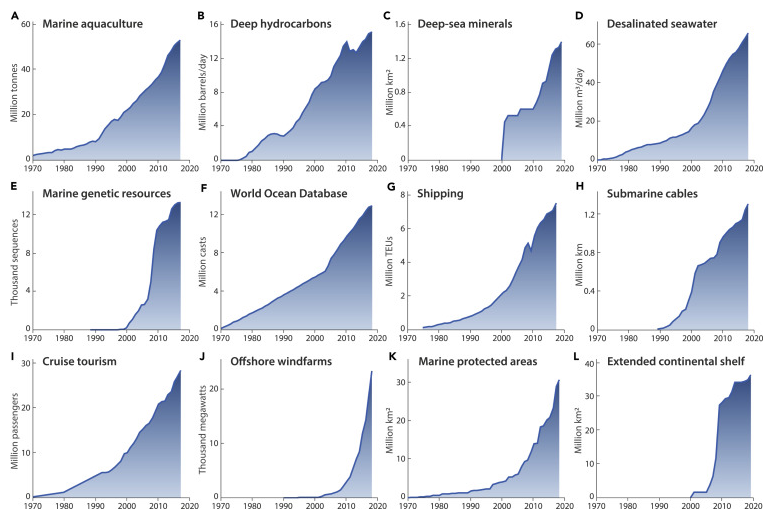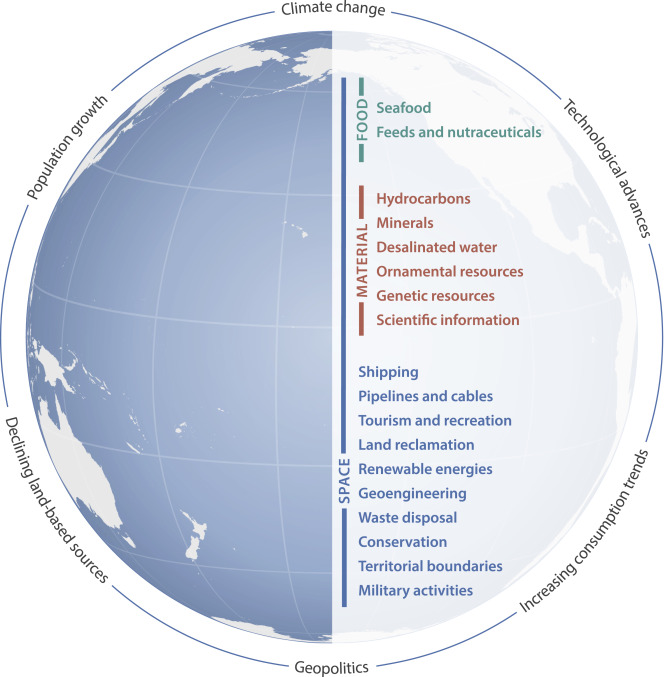The “blue acceleration”: Study shows humans’ surging incursions into the sea

By Grace Dungey
13 February 2020
(Mongabay) – Humanity has depended on the ocean for millennia. Today, however, the rush to the sea is occurring with unprecedented diversity and intensity, propelled by population growth and demand for diminishing terrestrial resources.
A study published in January in the new journal One Earth analyzed 50 years of data on 18 kinds of marine resource claims, broadly grouped as food, material and space. The authors, from the Stockholm Resilience Centre at Stockholm University, captured the results in a series of graphs showing the amount of activity since 1970 in areas such as marine aquaculture, shipping, deep hydrocarbons, and offshore windfarms. The graphs all show sharp upticks in the past 20 to 30 years.
The authors call this race for the sea the “blue acceleration.”
“The current narrative is that we are about to move into the ocean as the new frontier,” lead author Jean-Baptiste Jouffray, a Ph.D. candidate in sustainability science, told Mongabay. “However, when you look at the graphs, it has started already.”
Jouffray said he and his team are concerned about the increase in human activity in the oceans. They warn that the current approach could fundamentally alter the ecology not only of the oceans but of the global environment. “[Humanity hopes] the ocean will solve our need for food, freshwater, minerals, and will be the medicine chest for the future, but central to the blue acceleration is the idea that the ocean is not limitless,” he said.
Moreover, the current scale of activity in the oceans prioritizes the exploitation of ocean resources above scientific exploration, to the detriment of marine ecosystem health, Jouffray said.
Although some claims may complement each other, most will overlap and compete, creating potential conflict, he said. Some spatial claims are for marine protected areas, aimed at limiting resource exploitation, preserving ecosystem health and cultural and aesthetic values, and prioritizing some industries, such as tourism. There are calls for the global marine protected area coverage target, currently 10% of the ocean by 2020, to be increased to 30% by 2030. (About 5.7% is currently protected.) But these protected areas sometimes conflict with extractive claims, such as for hydrocarbons or minerals. [more]
The ‘blue acceleration’: Study shows humans’ surging incursions into the sea

The Blue Acceleration: The Trajectory of Human Expansion into the Ocean
ABSTRACT: Does humanity’s future lie in the ocean? As demand for resources continues to grow and land-based sources decline, expectations for the ocean as an engine of human development are increasing. Claiming marine resources and space is not new to humanity, but the extent, intensity, and diversity of today’s aspirations are unprecedented. We describe this as the blue acceleration—a race among diverse and often competing interests for ocean food, material, and space. Exploring what this new reality means for the global ocean and how to steer it in a sustainable and equitable way represents an urgent challenge.
The Blue Acceleration: The Trajectory of Human Expansion into the Ocean